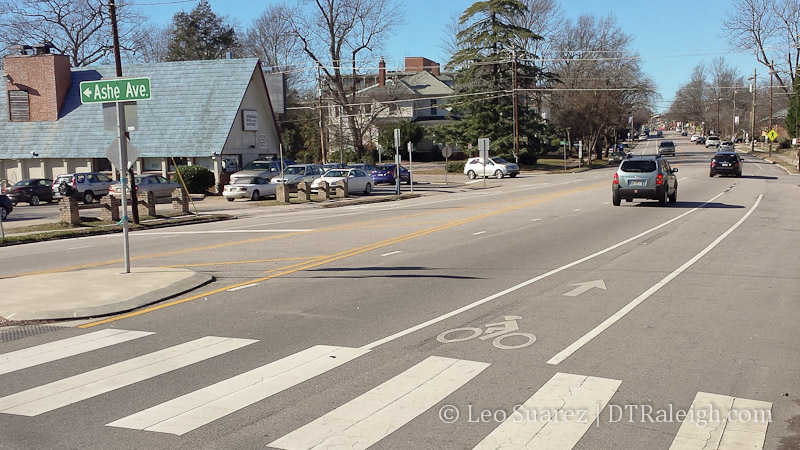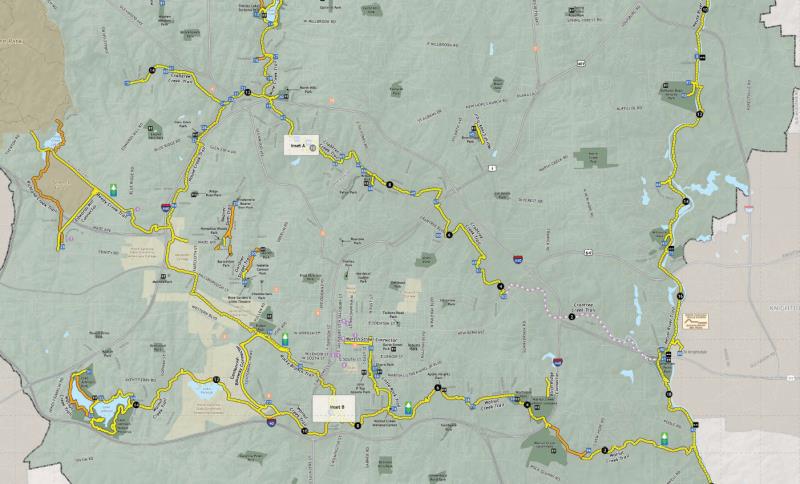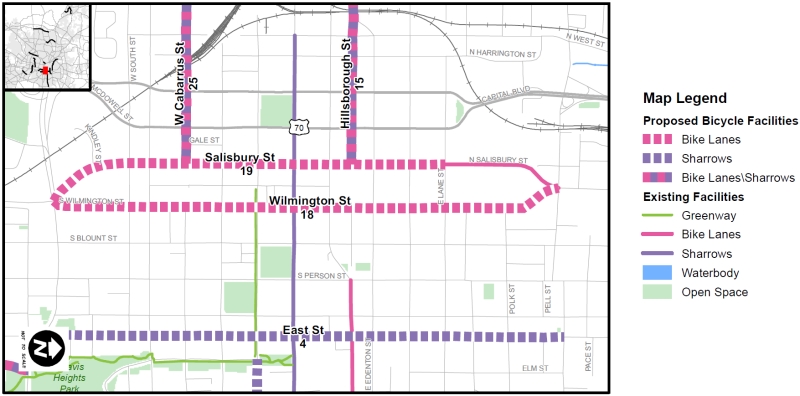
In April 2014, Raleigh’s premier bicycle festival, Oaks and Spokes, took place. The week long event combined community rides, cycling education, and a public forum that all focused around the idea of spreading the love of cycling culture in the city. Between the fun events and public information that took place that week, I had a thought about where we are heading with regards to bicycle infrastructure.
Are we spreading ourselves too thin with mediocre (at best) bike infrastructure here in Raleigh? Are bike lanes and sharrows really spreading the cycling culture throughout our city?
In my opinion, it almost feels like the efforts we’ve made are a bit timid while a lot of other cities are really cranking up the bicycle lanes, making them protected, scenic, and comfortable to use.
I’ll pick on one of the city’s currently ongoing bicycle projects. Through a $1.1 million grant, the city will install “27 miles of marked, on-road bicycle facilities.” This project has been mentioned on the blog before and the post lists several streets in and around downtown Raleigh that will get these bicycle facilities. The rest of the city is getting some bicycle love as well so it’s important to note that this is a city-wide effort.
The project page on the city’s website has now been updated with draft plans for each street. Take a look and get your feedback to the city before May 9.
Click for larger
For downtown, the proposed bike facilities include bike lanes on Wilmington and Salisbury between Peace Street and MLK Boulevard. Also, sharrows will be added to Hillsborough and Cabarrus Streets under the current draft. This is just a small piece of the larger network that is being built across the city.
Dedicated lanes and sharrows might be just paint on the road but it is a step towards creating that bicycle-friendly city. Certainly there is room for improvement on what’s being installed but $1.1 million can only do so much.
Is this a quantity (coverage) versus quality (safety) situation?
Certainly more miles of “marked, on-road bicycle facilities” sounds better than less but let’s discuss an alternative approach. If you think about other forms of transit, rail lines connect major areas to each other and then over time, new lines link up to that and form a network. Highways connect cities and over time have formed their own quality network. Just like them, one mega-bicycle project could be a success in Raleigh, sacrificing total coverage but being of a much higher quality.
Instead of 27 miles of paint for bike lanes and sharrows, what if we could get 5 miles of cycle tracks and/or protected lanes? A 5 mile direct route like this could really connect places, for example:
- It is about 5 miles along Hillsborough Street from the State Capitol to The Fairgrounds
- In the other direction, it is less than 5 miles from the Capitol to WakeMed along New Bern Avenue
- Glenwood South and North Hills could be connected using St. Mary’s and Lassiter Mill Road
Granted, these are highly simplistic ideas making a lot of assumptions and not taking into account a mountain of factors. However, if major connections are made between these centers of activity with high-quality bicycle facilities there may be more chances of cycle adoption, increased bicycle use in the city, and possibly giving more political backing for future projects just like it.
The Network
Mega-projects don’t just happen though. Our bicycle network, at least up until a few years ago, has been implemented from almost nothing in the city budget and some creative thinking from city planners. This includes adding bike lanes or sharrows when a road is due to be repaved, taking advantage of the need to re-stripe the street anyway.
What the city is doing to deliver our bicycle network is subtle and can be described as a slow boil. Just like the greenway network, which started being built in the 1970s, the bicycle network is being put together in any way that it can be, piece by piece.
When you look at the greenways, it is only recently that the they have really been making major connections to form that comprehensive network across the city.

So while huge projects can be fun and exciting, working towards that day when the bicycle network all comes together could be even more magical. That is one way to make Raleigh, from downtown to the outskirts, a complete bicycle friendly city.
Comments
Comments are disabled here. That's because we're all hanging out on the DTRaleigh Community, an online forum for passionate fans of the Oak City.


Love the idea of connecting major points with dedicated, protected lanes. Appreciate the current efforts of painted lanes but they just aren’t protective enough. It’d be great if the lanes were made in between parallel car spots and the sidewalk. That would make it feel much safer and bikers wouldn’t be in jeopardy when someone wanted to park. There are a lot of streets in and around downtown that could get that treatment. I’d love to see Blount St. reduced to a two lane and given a nice wide protected bike lane. It’s never busy enough to warrant three full lanes.
I agree with the concept of delivering a few protected bike transit corridors as a priority. The opportunistic approach of adding on bike lanes and sharrows to funded construction projects is adding sections of streets which are “bike aware” but less than safe for real transit by bike.
I have been experimenting riding a bike from North Raleigh to downtown via several routes with a combination of “bike friendly”, sharrows, bike lanes, greenways and city streets. It is difficult to put together a truly safe ride. Even new bike lanes are being painted between on street parking and automobile travel lanes. Driver side doors of parked cars will open into bike lanes.
Raleigh could make huge gains toward making bicycle commuting and short trips (shopping and dining out) a reality by creating safe biking corridors from downtown out to the outer reaches of the county. Doing so would that make Raleigh more attractive to high tech and healthcare employers and the youthful employees they would need to attract.
I think Raleigh has yet to embrace the idea that bike riding can be anything more than recreation.
I ride my bike everyday. All over Raleigh, from N. Raleigh to downtown and all places in between. Only about 5% of residents in Raleigh walk anywhere. Having said that, I use the sidewalks when I ride. Why not? I get it the sidewalks were made for walkers …but nobody walks on them. As far as sharrows go, I love them and I feel perfectly safe riding on them. Raleigh is a very bike friendly community, it’s just a shame bikers don’t use common sense and use the sidewalks on busy rds. I’ve never understood why people think they have to ride their bikes on dangerous rds. When maybe 3-5x they may have to yield to someone on the walking on the sidewalk?
It’s illegal to bike on sidewalks in many places. I don’t know about downtown Raleigh but it would be downright inconsiderate to bike on the sidewalks there. But you’re right that there are some roads where it’s really unsafe for bikers.
Raleigh is decent for biking within the beltline. When I went to NCSU I biked everywhere. Hillsborough is vastly better for bikes now than it was back then (2005-2009 ish). At the time, you were definitely sharing a 5 lane road with cars going 45 if you were biking downtown. I ended up taking the sidewalk depending on the time of day, but the sidewalks had harsh curbcuts on one side of the street that you couldn’t bike over.
I respect and admire those bikers who are willing to mix it up with cars on the roads, and who trust them to drive more carefully in the presence of marked bike lanes and sharrows. But personally, I would never seriously consider joining them.
IMHO, bike lanes and sharrows are a waste of perfectly good paint, and a very temporary solution at best. They’re especially onerous because they give politicians an out – a way to feel progressive and bicycle-friendly without actually doing anything.
Separate and dedicated bikeways are the only way to go, and would be well worth whatever it might cost to retrofit our transportation grid to include them. I would rate their importance to our city even higher than rail – which I consider a necessity.
Protected lanes are great but we cannot have them wherever there are bikers. Making streets appropriately safe for bikers, pedestrians, and cars is much more important and is only accomplished by creating a culture of awareness for other modes. Sharrows and lanes accomplish this in part. That said, creating connected corridors will also be important.
Once West Street is extended south under the tracks at Union Station and North to Wake Forest Rd – it should have a cycle track… which should then follow along Capital Blvd (separated) to meet the greenway just inside the beltline.
Another cycle track should go along Morgan St from the Hillsborough St roundabout and then along New Bern until the greenway at Milburnie Rd. (should be doable to fit cycle track and BRT along this corridor)
Person St/Wake Forest Rd could be a third corridor for a cycle track as well.
Bike safety is in numbers and I think we should try to consolidate much of the bike traffic to main corridors and then rely on sharrows and lanes to finish the trips.
[…] mid 2014, I did a post about the evolution of Raleigh’s bicycle network. It’s been years, it feels […]